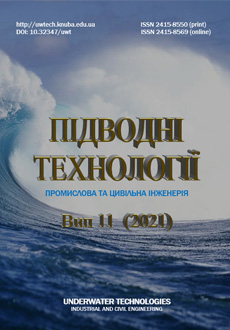Research of corrosion and mechanical resistance of reinforce-ment steels designated for operation in hydraulic structures
DOI:
https://doi.org/10.32347/uwt2021.11.1802Ключові слова:
corrosion destruction, flooding, crack resistance, endurance, fatigue strengthАнотація
Analytical inspection showed that with a long service life of reinforced concrete structures of hydraulic structures, their individual elements such as reinforcing bars are destroyed due to insufficient fatigue and corrosion strength of the reinforcement metal. They occur mainly under the action of the main variable loads − bending, vibrations of reinforced concrete slabs, mechanical and erosion of the environment. The main causes of failure of the valve are its rupture and wear due to repeated action of force factors. The surface zone of the reinforcement in connection with concrete is especially intensively destroyed due to weak adhesion strength. The use of low-strength reinforcing steels can also be one of the reasons for the failure of reinforcement joints with concrete. Improving the corrosion and mechanical reliability of reinforced concrete structures of hydraulic structures is possible through the use of: for the manufacture of reinforcing bars which are the main power structure of reinforced concrete economically modified alloy steels, which undergo complex heat treatment and are characterized by high corrosion and fatigue properties. alternating) loads; The resistance against SCRN, VIR and corrosion-mechanical fatigue of reinforcing steels intended for the construction industry has been studied.
It was found that the experimental steels, economically modified REE, copper-nickel, especially chromium niobium and vanadium meet the requirements of the International Standard NACE MR 0175-96 on chemical composition and mechanical properties, and steels of grades
10HSNDA and 20F do not have a sufficiently high resistance SCRN <limits σ0.2min) and corrosion-fatigue failure, and steels of grades 20F and 06G2B showed low resistance to VIR (CLR> 6% and CTR> 3%). Therefore, it is necessary to carry out a full (100%) input control of corrosion and mechanical resistance of all materials involved in the manufacture of reinforced concrete structures for hydraulic purposes for operation in hydrogen sulfide-containing environment.
Посилання
Makhutov N.A., 1981. Deformation criteria of destruction. Mashinostroenie, 272 (Russian).
Archakov Yu.I., 1980. Hydrogen corrosion of steel. Metallurgy (in Russian).
Atomic mechanism of destruction, 1983. Mir. 660 (in Russian).
Kalachev B.A., 1985. Hydrogen fragility of metals. Metallurgy, 216 (in Russian).
Meshkov Yu.Ya., 1985. Physical foundations of the strength of steel structures. Kiev, Naukova Dumka, 266 (in Russian).
Petrov L.N., Sopronyuk N.G. 1988. Corrosion-mechanical destruction of metals and alloys, Kiev, Naukova Dumka, 488 (in Russian).
Moskvin V.M. , 1980. Corrosion of concrete and reinforced concrete methods of their protection. Stroyizdat, 538 (in Russian).
Makarenko V.D., Mangura A.M., Sizonen-ko A.V., Litvyak O.L. 2019. Mechanisms of corrosion-carbon corrosion of structural pipe steels for naphtha and gas filling Modernization and engineering development of resource-saving technologies in the form of packaging and processing of brown copal ins. Collective monograph. Petro Shan, Ru-mania, Universities Publishing, 424 (57-70).
Makarenko V.,Vynnykov Y., Liashenko A., Petrash O., 2019. Hydrate Formations Modelling for the Oil and Gas Facilities Reconstruction, Proceedings of the 2nd International Conference on Building Innovations. ICBI Lecture Hydrate Formations Modeling for the Oil and Gas Facilities Re-construction Notes in Civil Engineering, vol 73. Springer, Cham. 651-658.
Boyko A.V., Makarenko V.D, Maximov S.Yu., 2021. On some mechanical characteristics of structural steels of cooling systems of long operation. Problems of durability, No.2 (470), 77-81 (in Russian).
Makarenko, V.D., & Morgun, I.D., 1991. Special features of the effect of barium on the mechanical properties of metal deposited in welding with calcium fluoride electrodes. Welding International, 5(9), 726-728 (in Russian).
Pokhodnya I.K., Ponomarev V.E., Mili-chenko S.S., Skorina N.V., Makarenko V.D., Marchenko A.E., & Gorpenyuk, V.N., 1987. Effects of type of binder and its composition on the welding and properties of electrodes with basic coatings. Welding International, 1(2), 116-118 (in Russian).
Kreshchanovsky I.S., Sidorenko M.F., 1970. Modification of steel, Metallurgy. 296 (in Russian).
NACE Standard TMO 177-90, 1990. Standard Test Method Laboratory Testing of Metals for Resistance to Sulfide Stress Cracking in H2S Environments, NACE Houston.P.O. Box 218340, 22.
MSKR-01-85, 1985. The test procedure for resistance to hydrogen sulfide stress corrosion cracking. Publishing house of the State Committee for Science and Technology of the USSR, 8.
Makarenko V.D., Shatilo S.P., 1999. In-creasing desulphurisation of the metal of welded joints in oil pipelines. Welding Inter-national. 56-61 (in Russian).
Makarenko V.D., Beljaev V.A., Protasov V.N., Shatilo S.P., 2000. Mathematical model of the mechanism of resistance of welded joints in oil and gas pipelines to static hydro-gen fatigue. Welding International, 83-88 (in Russian).
Sukach M.K., 2018. Theoretical foundations for the calculation of staple-shaped leaf springs. Transfer of Innovative Technologies, Vol.1, No.2, 40-50. https://doi.org/10.31493/tit1812.0201.
Horbatenko Y.G., 2020. The production of the splash phenomenon, as a way of dissipating the energy of a gravitational wave. Underwater Technologies. Vol.10, 58-67.
Sukach M.K., 2021. The Staple-ShapePlate Springs Engineering Calculation Method. Science and Technique. 20 (3), 268-274, https://doi.org/10.21122/2227-1031-2021-20-3.
##submission.downloads##
Опубліковано
Як цитувати
Номер
Розділ
Ліцензія
Авторське право (c) 2021 Mykhailo Sukach, Myroslav Kindrachuk, Valeriy Makarenko

Ця робота ліцензується відповідно до Creative Commons Attribution 4.0 International License.
Автор(и) та Редакція згодні на те, що Редакція також матиме право:
- здійснювати необхідне оформлення Твору/Статті за результатами його редакційної обробки;
- визначати самостійно кількість видань, друк додаткових копій і тираж Твору/Статті, кількість копій окремих видань і додаткових тиражів;
- опублікування Твору/Статті в інших виданнях, пов’язаних з діяльністю Редакції

